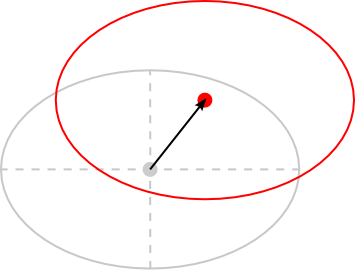Class TLspSurfaceEditor
java.lang.Object
com.luciad.view.lightspeed.editor.ALspEditor
com.luciad.view.lightspeed.editor.TLspSurfaceEditor
- All Implemented Interfaces:
ILspEditor
Enables visual editing of
Note: This only applies to surfaces with no interior rings.
ILcdEditableSurface objects in an
ILspView.
Handles
The surface editor defines the following edit handles for a surface:- Object translation handle: allows the user to translate the surface. This handle
generates
MOVEoperations, with a xy constraint, without any additional properties.
- ILcdCompositeCurve
- ILcd2DPointList
- ILcdCircle
- ILcdCirlceBy3Points
- ILcdArcBand
- ILcdEllipse
Note: This only applies to surfaces with no interior rings.
Editing
Based on theTLspEditOperation, generated by an edit handle (see description
of handles above), this editor performs different edit operations on the associated surface.
The images below illustrate the effect of the different handles. In each image the
gray color represents the previous state of the object and the red color represents the edited object:
- Object translation handle

Creation
This editor does not support creation. For creation, refer to any of the more concrete editors available.- Since:
- 2012.0
-
Constructor Summary
Constructors -
Method Summary
Modifier and TypeMethodDescriptionbooleancanEdit(TLspEditContext aContext) protected ALspEditHandlecreateObjectTranslationHandle(ILcdEditableSurface aSurface, TLspEditContext aContext) Creates an edit handle that allows the user to translate the given shape.protected TLspEditOperationResulteditImpl(TLspEditOperation aOperation, ELspInteractionStatus aInteractionStatus, TLspEditContext aContext) Called by theeditmethod to edit the given object based on the givenedit operation.getCreateHandle(TLspEditContext aContext) Returns a handle that is used to create the given object.Get the Creation Mode behavior for creating point list surfaces.Gets the curve connector provider, used to ensure that the surface's rings being edited stay nicely connected.getEditHandles(TLspEditContext aContext) Returns a set of handles for editing the given object.voidsetCreationMode(ELspCreationMode aCreationMode) Set the Creation Mode behavior for creating point list surfaces.voidsetCurveConnectorProvider(ILcdCurveConnectorProvider aCurveConnectorProvider) Sets the curve connector provider, used to ensure that the surface's rings being edited stay nicely connected.Methods inherited from class com.luciad.view.lightspeed.editor.ALspEditor
canCopyGeometry, canPerformOperation, copyGeometrySFCT, edit, fireUndoableHappened
-
Constructor Details
-
TLspSurfaceEditor
public TLspSurfaceEditor()Creates a newTLspSurfaceEditor. This constructor does not initialize any state.
-
-
Method Details
-
canEdit
- Specified by:
canEditin interfaceILspEditor- Overrides:
canEditin classALspEditor- Parameters:
aContext- provides context information to the editor- Returns:
trueif the above conditions are met,falseotherwise.
-
getEditHandles
Returns a set of handles for editing the given object. These handles will be able to generate edit operations, that are passed to theeditmethod. As a way to communicate with this method, handles will copy their properties to the edit operation properties. By default this method delegates to thecreateObjectTranslationHandlemethod. It is added for convenience, so it can easily be overridden. This method returns either a list with a single handle, or an empty list.- Parameters:
aContext- provides context information such as the layer for which the object is being edited- Returns:
- the edit handles to edit the given object, or an empty list if it should not be possible to edit the given object.
- See Also:
-
createObjectTranslationHandle
protected ALspEditHandle createObjectTranslationHandle(ILcdEditableSurface aSurface, TLspEditContext aContext) Creates an edit handle that allows the user to translate the given shape. By default this is aTLspObjectTranslationHandle.- Parameters:
aSurface- the shape for which the handle is createdaContext- the current context- Returns:
- an edit handle or
nullif no handle is needed
-
getCreateHandle
Returns a handle that is used to create the given object. The returned handle is used by the controller to initialize the other of the object. Typically the returned handle is an instance ofALspCreateHandlewhich is a specialized handle implementation used for creating an object. If the surface contains a supported outer ring and no inner rings, this method delegates to the appropriate ring editor. Otherwise, the method returnsnull.- Parameters:
aContext- provides context information such as the layer for which the object is being created- Returns:
- a create handle or
null - See Also:
-
editImpl
protected TLspEditOperationResult editImpl(TLspEditOperation aOperation, ELspInteractionStatus aInteractionStatus, TLspEditContext aContext) Called by theeditmethod to edit the given object based on the givenedit operation. Note that this method does not need to lock the model of the object, this already happens in theeditmethod. By default, this editor can handle the following operations:- Specified by:
editImplin classALspEditor- Parameters:
aOperation- the event that contains the information on how to edit the objectaInteractionStatus- the interaction statusaContext- the edit context- Returns:
- The result of the operation: Whether or not there was success, and whether or not the current handles of the object should be invalidated.
-
getCurveConnectorProvider
Gets the curve connector provider, used to ensure that the surface's rings being edited stay nicely connected. The default curve connector provider isTLcdDefaultCurveConnectorProvider.- Returns:
- the set curve connector provider
-
setCurveConnectorProvider
Sets the curve connector provider, used to ensure that the surface's rings being edited stay nicely connected.- Parameters:
aCurveConnectorProvider- the new curve connector provider, ornullif curves should not be connected
-
getCreationMode
Get the Creation Mode behavior for creating point list surfaces.- Returns:
- the Creation Mode of the point list editor
-
setCreationMode
Set the Creation Mode behavior for creating point list surfaces.- Parameters:
aCreationMode- the Creation Mode
-